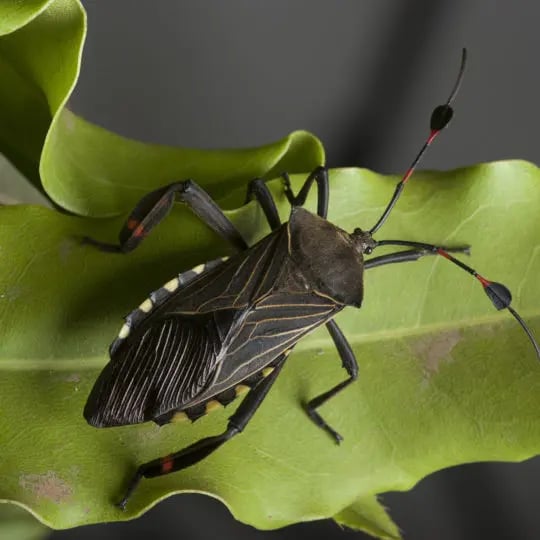Lawn Pest Library
Chinch Bugs

Scientific Name: Blissus leucopterus
Lifespan: Less than one year
Brief description: This bug gets its name from the Spanish word chinche, or “pest.” The chinch bug has been pestering North America for centuries; records of the insect damaging crops on this continent date back to the 1700s. These tiny critters feed on stems of turfgrass, sucking the grass blades dry and then injecting a toxin into the plants that kills them.
What are Chinch Bugs?
Chinch bugs are small in size (adults are only ⅙ inch long), but they can do serious damage to a lawn. Chinch bugs seek out arid, hot, and sunny environments to live and breed, and they cause the most damage during the hottest and driest months of the year. The hairy and common chinch bugs are the predominant two species of chinch bug in the United States. The hairy chinch bug attacks northern turfgrasses such as Kentucky bluegrass, perennial ryegrass, and fescues, and it favors lawns that are more than 50 percent Kentucky bluegrass. The common chinch also can be observed on turfgrasses, though it prefers grain crops such as corn and wheat.
Chinch bugs have three stages: egg, nymphal (young), and adult. The bugs overwinter in hedgerows, road sides, and other protected areas, then emerge in late spring to feast on grasses and breed. In mid-summer, females lay about 200 eggs in folds of grass blades, and when the nymphs hatch, they suck out the sap from the grass sheaths and stems with their needle-like mouthpieces. Both the nymph and adult chinch bugs have the needle mouthparts. As their feeding continues and intensifies, grass turns yellow and then brown.
Signs and Symptoms of Chinch Bugs
If you judiciously feed and water your lawn, only to find it showing signs of drought damage, consider the possibility of a chinch bug infestation. Turf that is truly parched will respond quickly to watering, but if it has been overtaken by chinch bugs, it will not. You may notice yellow spots of grass next to driveways, sidewalks, or the foundation of a home, areas that are naturally warmer and beckon the heat-loving chinch. Particularly in hot, dry weather, small yellow patches will gradually become large sections of damaged turf.
Find out if you are entertaining an army of chinch bugs by getting down on your hands and knees and visually inspect the grass in a suspected area of lawn. Chinch bugs can range in color from light red to orange (nymphal stage) to black (adult). Nymphs have a white stripe across their abdomen, and adults have white on their backs, between their wings. Confirm an infestation with the tin can trick. Cut both sides off of a tin can, and push one end down into the ground in a spot where the yellow-brown grass meets green grass. Then pour water into the can so that the water is above grass level, and wait ten minutes. If you have chinch bugs, they will begin to float to the surface of the water.
How to Prevent Chinch Bugs
Keep a healthy lawn by mowing at the maximum recommended height, feeding it a lean diet of fertilizer (without overdoing it), aerating the soil, and watering regularly, particularly during very hot and dry weather. Since chinch bugs congregate in turf thatch, remove excess thatch from your lawn with a special dethatching rake or by hiring a professional lawn care service.
Overfertilization with nitrogen is tied to increased chinch bug populations, so use small amounts of nitrogen fertilizer during the summer or use a slow-release formula.
A number of insecticides are available to prevent and control chinch bug populations. They are usually successful if applied early on. Synthetic pyrethroid insecticides (all of which end in “thrin”) are viable options. These include bifenthrin (Ortho Max Bug-B-Gon, Over ‘n Out and Hi-Yield Bug Blaster), cyfluthrin (Bayer Advanced), lamda-cyhalothrin (Spectracide) and permethrin (Green Light and Spectracide). All are available at garden supply stores.
Treatments come in granular and liquid form. Granular insecticides can be applied with a standard fertilizer spreader. Liquid sprays can be applied with a hose-end sprayer. Adding a small amount of dishwashing solution to your liquid spray can help improve control and coverage of the area.
If chinch bugs are damaging just a small section of the yard, apply spot treatment with insecticide first. Otherwise, you could inadvertently kill the big-eyed bug, one of the chinch bugs’ natural enemies.
Chinch bugs reproduce rapidly and can develop resistance to an active ingredient just as fast. It can be advantageous to switch up the class of insecticide you use if you need to treat the lawn more than once.
For chronic chinch bug problems, contact your local lawn care specialist. They can determine a treatment plan that is more likely to achieve lasting control over these pests.
Need Help with Chinch Bugs?
Call today at and let's talk about how we can help you with Chinch Bugs and other Lawn Pest Library.